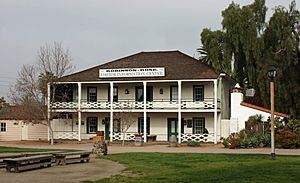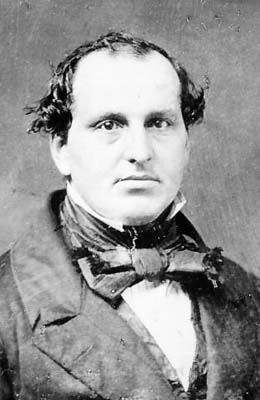John Judson Ames facts for kids
John Judson Ames (born May 18, 1821 – died July 28, 1861) was an important early settler in California. He was known as a "California Pioneer." He also started and ran the very first newspaper in the city of San Diego, California, USA. He sometimes used the pen name "Boston" when he wrote.
Contents
Early Life
John Judson Ames was born in Islesboro, Maine on May 18, 1821. His family was originally from Marshfield, Massachusetts. His father, John Gilkey Ames, built ships and traded along the coast. His mother was Abigail Dodge.
Judson Ames left home when he was about 16 years old. His father told him to be hardworking and careful with his money. Not much is known about his early life after that. He had some schooling and also traveled a lot by sea. He had a younger brother named Hudson N. Ames.
Starting a Career
Around 1847, John Judson Ames started working for Henry O'Reilly. O'Reilly was famous for building early telegraph lines. Ames helped build the first long telegraph line from Memphis, Tennessee down to New Orleans.
After moving to Louisiana, Ames became interested in newspapers. He started a paper called The Dime Catcher in Baton Rouge, Louisiana. This city was the new capital of Louisiana. He used his newspaper to support General Zachary Taylor in the 1848 United States presidential election.
The California Gold Rush
In 1848, people discovered gold in California. This news, called the "gold fever," reached Louisiana. Ames decided to close his newspaper office and travel to California. He went by crossing the Isthmus of Panama.
He arrived in San Francisco on October 28, 1849, with no money. He borrowed a handcart and started carrying luggage for people. He always kept the first coin he earned from this job as a special memory. Soon, he began writing for newspapers. He worked as an editor for the Placer Times and Transcript. He also wrote for other papers using his favorite pen name, "Boston."
San Diego's First Newspaper
In 1850, Ames visited Honolulu. When he returned, he heard that San Diego needed a newspaper. He visited San Diego and announced his plans for a new paper in December 1850.
Another newspaper, La Estrella de Los Angeles, started in Los Angeles on May 17, 1851. This was the first newspaper in the Southwest. Ames's paper, the San Diego Herald, came out just twelve days later, on May 29.
Ames had support from politicians like Senator William M. Gwin and Governor John B. Weller. They wanted to divide California into two states. They also hoped to build the first transcontinental railway with San Diego as the end point. Ames worked with Gwin for a while, but later they had a disagreement.
Running the San Diego Herald
Ames worked hard to set up his newspaper office and get advertisements. The San Diego Herald first had four small pages with four columns each. It was published every Thursday. A yearly subscription cost US$10. In January 1852, the paper started coming out on Saturdays.
The newspaper included local news, national and international news from arriving ships, and an editorial. Ames often traveled to San Francisco to get more advertisements. The paper was made bigger twice, in 1853 and 1854. When it was first enlarged, the price dropped to $5 per year. By 1854, it had seven columns. Ames claimed the Herald had the most readers of any paper in California.
Ames said his paper would be "Independent, but not Neutral." He didn't take a strong side in the 1851 political campaigns. But two years later, he supported the Democrats and John Bigler for Governor. In 1856, he joined the "Know Nothing" party, but later returned to the Democrats. He often disagreed with President Franklin Pierce. This was likely because Pierce stopped funding for improvements to the San Diego River.
Challenges and Changes
Publishing a newspaper in a frontier town like San Diego was difficult. There wasn't much local news. Sometimes, the paper didn't receive news from other places. Ames even printed lists of post offices or government circulars to fill pages.
Most Americans in San Diego, including Ames, hoped that Baja California would become part of the U.S. However, because of the military presence, they couldn't openly support this idea.
Ames was often away from San Diego. He would go to San Francisco to get ads, collect money, and relax. On August 27, 1852, he announced he was leaving. The newspaper office would close, and the paper would stop publishing temporarily.
While Ames was away, a man named William N. Walton arrived. He convinced Ames's lawyer, Judge James W. Robinson, that Ames had agreed for him to take over the Herald. Walton seemed to know a lot about Ames and the paper. So, Robinson let him take charge.

Ames returned in March 1853, and Walton quickly left. In July 1853, Ames became an aide to Major-General David B. Kurtz in the state militia, with the rank of captain. Around this time, the Herald moved its office to Old Town, San Diego. It was on the second floor of a building near the Old Town plaza. For the next seven years, the paper showed more about the Spanish-American life in the community.
In late 1853, Ames left his paper to Lieutenant George Derby for a while. Later, Ames helped put together a book of Derby's humorous writings.
On April 21, 1855, Ames announced he was leaving for the East Coast. The paper printed about 500 copies per issue and provided him a good living. He probably had other money, perhaps from his father's family. He tried to sell the paper but couldn't. During his trips, he wrote long, funny letters to the Herald using his "Boston" pen name. He also wrote poems.
Ames was also a notary public in San Diego for many years. This job added to his income. He was elected as a councilman and a justice of the peace. He also served as the county superintendent of schools and a flour inspector for San Diego County.
Personal Life
John Judson Ames was a Mason. He helped start the first Masonic lodge in San Diego, which was also the first in Southern California. He was the leader of this lodge for a time.
He was married three times. His first wife was Emily Balch. They had a daughter, Helen, and a son, George Gordon. Both children died young. This marriage ended in divorce. His second wife was Eliza, who died in San Diego in 1857. His third wife survived him. After Ames died, she remarried. With his third wife, Ames had one son, Hudson, who was born in San Diego in 1859 and died in 1863. John Judson Ames himself died in 1861.


